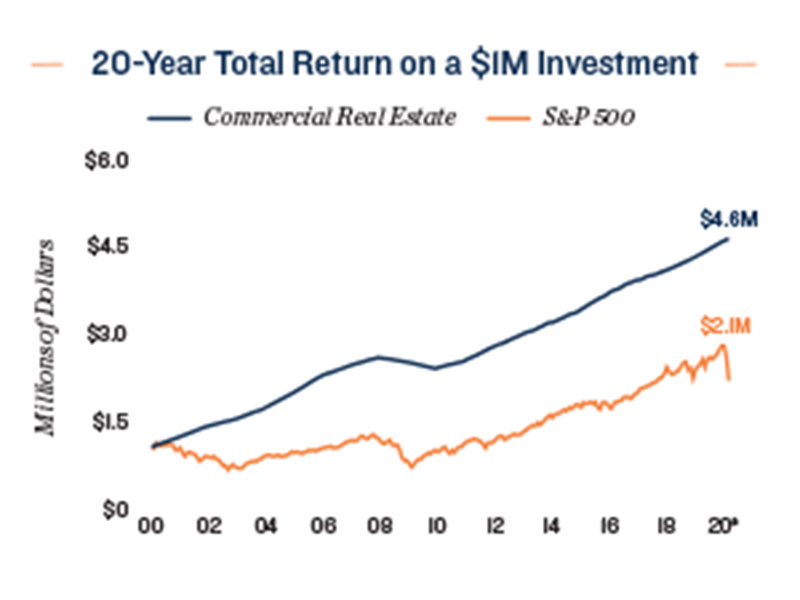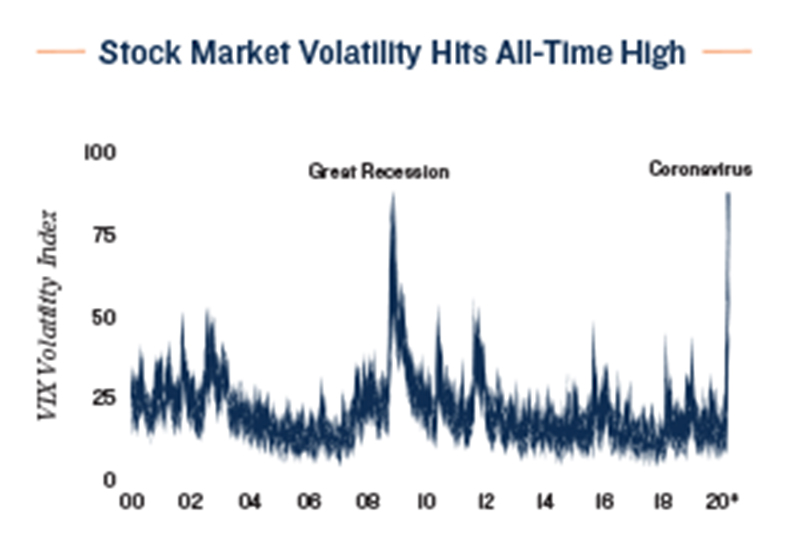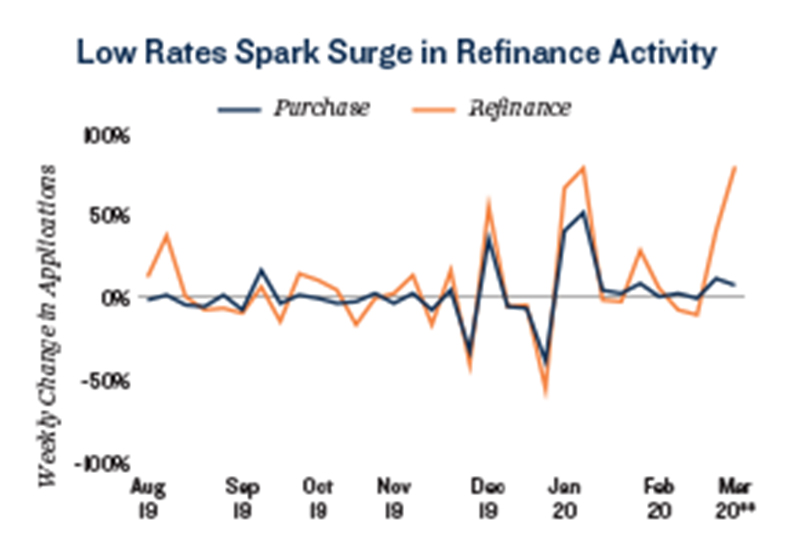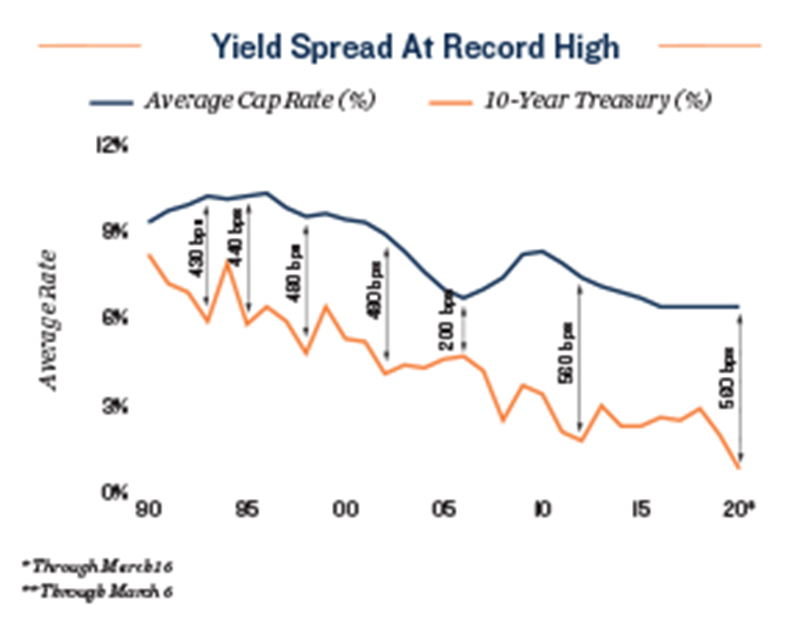Special Report from Marcus & Millichap: Balancing portfolios in a transitioning market - by John Chang

Stock Market Volatility Index Reaches Record High; Turbulence Reinforces Stability of Real Estate Investments
Stock market correction spurs portfolio recalibration
 As the new coronavirus (COVID-19) broke free from China, the prospects of increased economic risks drove Wall Street into a flight to safety. Over the course of the following three weeks, the S&P 500 index fell 30 percent and pushed the 10-year Treasury to a record low, briefly touching 0.42 percent on March 9. Since touching that intraday low, the Treasury rate has been on an upward trajectory. Market turbulence remains elevated, with the volatility index reaching its highest level on record. This has reiterated the comparative stabil- ity of real estate investments, while the record-low interest rates have sparked an increased appetite for acquisitions and a wave of refinance activity.
As the new coronavirus (COVID-19) broke free from China, the prospects of increased economic risks drove Wall Street into a flight to safety. Over the course of the following three weeks, the S&P 500 index fell 30 percent and pushed the 10-year Treasury to a record low, briefly touching 0.42 percent on March 9. Since touching that intraday low, the Treasury rate has been on an upward trajectory. Market turbulence remains elevated, with the volatility index reaching its highest level on record. This has reiterated the comparative stabil- ity of real estate investments, while the record-low interest rates have sparked an increased appetite for acquisitions and a wave of refinance activity.
Federal Reserve takes decisive action to sustain market liquidity
 To invigorate the economy during this period of uncertainty and pro-actively ensure capital markets do not lock up domestically or internationally, the Fed has taken swift action. On March 3, the Federal Reserve made an emergency 50-basis-point reduction to the overnight rate and later committed to more than $1 trillion of Treasury purchases and repurchase agreements. Following President Trump’s declaration of a national emergency on March 13, the Fed followed with an additional 100-basis-point cut and a commitment to $700 billion of quantitative easing. This takes the Fed funds rate back the 0-0.25 percent range, where it was through much of the Great Recession, keeping the interest rate climate low to fuel spending to support economic growth. While the Fed’s action has been so swift that it caught Wall Street by surprise, creating short-term volatility, it has also demonstrated the commitment to getting ahead of the biggest financial market risks.
To invigorate the economy during this period of uncertainty and pro-actively ensure capital markets do not lock up domestically or internationally, the Fed has taken swift action. On March 3, the Federal Reserve made an emergency 50-basis-point reduction to the overnight rate and later committed to more than $1 trillion of Treasury purchases and repurchase agreements. Following President Trump’s declaration of a national emergency on March 13, the Fed followed with an additional 100-basis-point cut and a commitment to $700 billion of quantitative easing. This takes the Fed funds rate back the 0-0.25 percent range, where it was through much of the Great Recession, keeping the interest rate climate low to fuel spending to support economic growth. While the Fed’s action has been so swift that it caught Wall Street by surprise, creating short-term volatility, it has also demonstrated the commitment to getting ahead of the biggest financial market risks.
Real estate investments deliver outsized long-term returns
While the stock market delivered exceptional total returns in excess of 25 percent last year, the recent correction has demonstrated how much volatility risk goes with that yield. Comparably, real es- tate investments averaged a total return of 7 percent last year, but without the whipsaw repricing experienced by Wall Street. Comparing the two asset classes over the long term demonstrates the advantages of real estate. An investment made 20 years ago, at the beginning of the year 2000, has delivered dramatically different results. The average total return on commercial real estate over this time has topped 359 percent while the stock market has delivered a 115 percent return. Even without considering the recent stock market correction, real estate outperformed.
Financial Market Trends
 Wall Street downturn significant but moderate compared with past corrections
Wall Street downturn significant but moderate compared with past corrections
Over the course of three weeks, the stock market fell by 30 percent with dramatic single-day moves both up and down. While the new coronavirus sparked the selloff, the stock market was particularly vulnerable to a correction. Over the course of 2019, the stock market valuation increased to a record level that was not substantiated by comparable earnings in the 12 months leading up to the virus outbreak. By comparison, the stock market fell by 56 percent during the financial crisis in 2007 and by 49 percent in the early 2000s as the dot-com bubble burst. Though this downturn is significant and has yet to fully play out, much of the current momentum is fear-driven. As additional information and clarity emerges, market dynamics should begin to stabilize.
Record-low interest rates boost investor returns
 The flight to safety placed strong downward pressure on interest rates, pushing the 10-year Treasury to an all-time low. Investors have responded with a surge of refinancing activity and an increased interest in acquisitions. Total refinance activity surged in the first week of March, climbing by 79 percent over the last week of February. Numerous buyers also capitalized on the unique timing to lock in rates in the high-2 percent to low-3 percent range. While investors can still capitalize on low rates, many lenders have opened their spreads to moderate their downside risk. The low interest rate climate will help investors achieve stronger levered yields as the spread between the 10-year Treasury and average cap rates set a new 30-year record.
The flight to safety placed strong downward pressure on interest rates, pushing the 10-year Treasury to an all-time low. Investors have responded with a surge of refinancing activity and an increased interest in acquisitions. Total refinance activity surged in the first week of March, climbing by 79 percent over the last week of February. Numerous buyers also capitalized on the unique timing to lock in rates in the high-2 percent to low-3 percent range. While investors can still capitalize on low rates, many lenders have opened their spreads to moderate their downside risk. The low interest rate climate will help investors achieve stronger levered yields as the spread between the 10-year Treasury and average cap rates set a new 30-year record.
Investment Trends
Yield spreads offer unique investment climate
 While investors often anticipate buying properties at reduced prices during periods of uncertainty, similar results can be created by locking in lower interest rates. Obtaining an exceptionally low interest rate generates a stronger yield as positive leverage delivers the upside. If an investor borrows money at 3 percent to purchase a property with a 5 percent cap rate, their 2 percent arbitrage lifts their levered yield significantly. While some investors go to the sidelines and await market clarity, others are maximizing their returns by locking in a lower cost of capital.
While investors often anticipate buying properties at reduced prices during periods of uncertainty, similar results can be created by locking in lower interest rates. Obtaining an exceptionally low interest rate generates a stronger yield as positive leverage delivers the upside. If an investor borrows money at 3 percent to purchase a property with a 5 percent cap rate, their 2 percent arbitrage lifts their levered yield significantly. While some investors go to the sidelines and await market clarity, others are maximizing their returns by locking in a lower cost of capital.
John Chang is senior vice president, national director | research services division at Marcus & Millichap.
AmTrustRE completes $211m acquisition of 260 Madison Ave.


Lasting effects of eminent domain on commercial development - by Sebastian Jablonski

Strategic pause - by Shallini Mehra and Chirag Doshi

AI comes to public relations, but be cautious, experts say - by Harry Zlokower









.jpg)
.gif)
.gif)